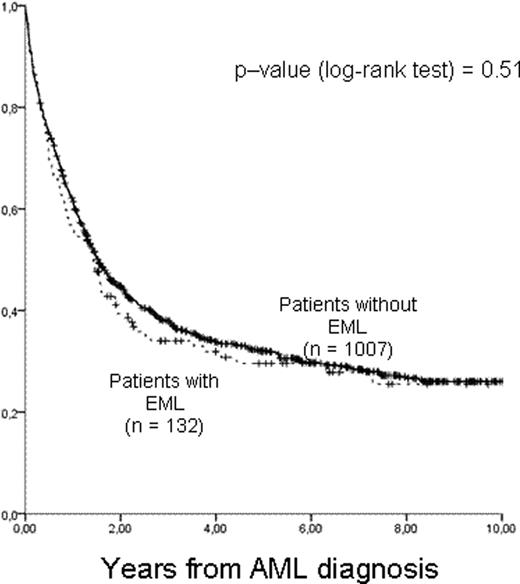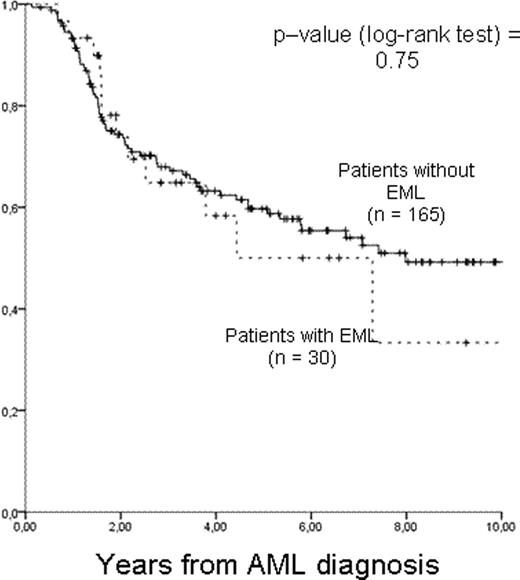Abstract
Abstract 2003
The prognosis of patients suffering from AML with manifestations of accompanying extramedullary leukemia (EML) including myeloid sarcoma (MS) compared to that of AML patients not exhibiting EML manifestations is still an open question as results from previous studies have been contradictory most likely due to selection bias.
Here we present an analysis performed in a cohort of 2261 patients representing >90% of all AML patients diagnosed and treated in Denmark during the eleven-year period January 2000 through December 2010. The goal was to investigate the prognostic impact of presence of EML at time of AML diagnosis by a retrospective population- and registry-based analysis
Of these patients, 219 (9.7%) showed signs of EML at time of AML presentation. Anatomic sites of EML were: lymph nodes (3.0%), skin (2.7%), spleen (1.7%), oral (1.3%), CNS (0.4%), testes (0.2%), other sites (1.1%), and two or more anatomical sites (0.5%). In 27 cases myeloid sarcoma was not accompanied by AML in the bone marrow and, thus, presented as isolated MS. In total, 1168 of the 2261 (52 %) patients were treated with curative intention. Allogeneic stem cell transplantation (Standard allo in 105 cases, and reduced intensity conditioning (RIC) transplant in 90 cases) was conducted in a total of 195 patients (118 in CR1, 65 in CR2, and 12 during other disease stages). Overall the frequencies of allogeneic transplantations in curatively treated patients were 13.7% in patients with EML and 8.5% in patients without EML.
Years from AML diagnosis
Patients with EML
(n = 132)
Patients without EML
(n = 1007)
p-value (log-rank test) = 0.51
Years from AML diagnosis
Patients with EML
(n = 132)
Patients without EML
(n = 1007)
p-value (log-rank test) = 0.51
Factors of significance to probability of attainment of CR and to overall survival (OS)
| . | Probability of CR (Logistic regression, nevaluable = 927) . | Probability of overall survival (Cox regression, nevaluable = 958) . | ||||
|---|---|---|---|---|---|---|
| Variable . | Odds ratio (OR) . | 95% CI of OR . | P value . | Hazard ratio . | 95% CI of HR . | P value . |
| EML | – | – | 0.82 | – | – | 0.54 |
| Age | 1.06 | 1.04–1.08 | <10−4 | 1.04 | 1.03–1.04 | <10−4 |
| Cytogenetics | 2.29 | 1.63–3.21 | <10−4 | 1.93 | 1.65–2.25 | <10−4 |
| Male gender | 1.48 | 1.03–2.07 | 0.03 | – | – | 0.06 |
| WBC | 1.005 | 1.002–1.007 | <10−4 | 1.001 | 1.000–1.002 | 0.02 |
| Secondary | 2.15 | 1.47–3.14 | <10−4 | 1.39 | 1.15–1.68 | 0.001 |
| . | Probability of CR (Logistic regression, nevaluable = 927) . | Probability of overall survival (Cox regression, nevaluable = 958) . | ||||
|---|---|---|---|---|---|---|
| Variable . | Odds ratio (OR) . | 95% CI of OR . | P value . | Hazard ratio . | 95% CI of HR . | P value . |
| EML | – | – | 0.82 | – | – | 0.54 |
| Age | 1.06 | 1.04–1.08 | <10−4 | 1.04 | 1.03–1.04 | <10−4 |
| Cytogenetics | 2.29 | 1.63–3.21 | <10−4 | 1.93 | 1.65–2.25 | <10−4 |
| Male gender | 1.48 | 1.03–2.07 | 0.03 | – | – | 0.06 |
| WBC | 1.005 | 1.002–1.007 | <10−4 | 1.001 | 1.000–1.002 | 0.02 |
| Secondary | 2.15 | 1.47–3.14 | <10−4 | 1.39 | 1.15–1.68 | 0.001 |
Years from AML diagnosis
Patients without EML
(n = 165)
Patients with EML
(n = 30)
p-value (log-rank test) = 0.75
Years from AML diagnosis
Patients without EML
(n = 165)
Patients with EML
(n = 30)
p-value (log-rank test) = 0.75
From this analysis we conclude that presence of EML does not predict for an inferior CR-rate or for shorter survival in AML. We find no clear justification for a more aggressive therapeutic approach or performance of allogeneic stem cell transplantation in AML patients with EML. Therapeutic decisions should be guided by other prognostic parameters, e.g., age and cytogenetic aberrations which are of far greater importance than the presence of EML.
No relevant conflicts of interest to declare.
Author notes
Asterisk with author names denotes non-ASH members.



This feature is available to Subscribers Only
Sign In or Create an Account Close Modal